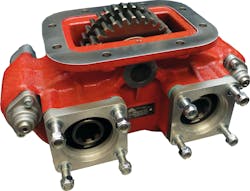The International Harvester company generally gets credit for introducing the first viable power takeoff drive (PTO) in 1918. And ever since, these virtually bulletproof drive systems have been letting vocational truck owners do far more than simply transport goods. PTOs can power any number of mechanical systems on a truck—from booms and buckets to powered accessories like augers or cable reels.
But in an age of connected, self-diagnosing components, systems, and vehicles, even tried-and-true PTOs are undergoing changes that will allow them to perform even better for fleets.
Tim Bauer, VP of aftermarket at Eaton Vehicle Group, said most of the enhancements for PTOs in the current market are around material enhancements to improve durability and reliability. He noted there are also more options offered in terms of gear ratios, mounting types, and other tweaks to accommodate higher pressures and lower-speed pumps.
“Rear mounted PTOs are now gaining popularity in the U.S. market,” Bauer explained. “They are great for tight spaces and typically are easier to install and set up. The rear location provides improved ground clearance and more room to directly mount the pump to the PTO and facilitates easier hose routing.”
Another important trend being closely watched by OEMs and suppliers is the shift toward more battery-electric trucks—particularly hybrid drive powertrains.
“Typical applications remain the same,” Bauer noted. “However, electrification on some applications will change how the mobile power systems are powered, which will require some changes to the design of the systems and the PTOs.”
Electrification of some vocational applications will certainly present some opportunities for new configurations, Bauer explained. One example is split shaft boxes designed to charge batteries. “As a result,” he added, “we continue to evaluate trends in the market and will have products available when the markets transition.”
Daimler Truck North America has been doing this for a few years, notably with the Western Star 49X. The vocational truck launched in 2021 and featured customizable PTO presettings.
“We’ve given operators the ability, through the new Driver Command Center in the instrument cluster, to control engine speed when in PTO mode simply using steering wheel buttons,” explained Dan Silbernagel, vocational segment strategy manager at DTNA.
“There have been many enhancements with new technology in electrical systems and powertrains, truck equipment manufacturers (TEMs) and fleets can interface with PTOs in new ways,” Silbernagel said.
According to Silbernagel, fleets now can specify more truck and powertrain functionality as it relates to PTO engagement and functionality than before. TEMs and fleets can spec or program safety interlocks to protect their equipment or the operator, for example, as well as program PTO parameters and body functionality through web-based applications.
He also noted DTNA’s Custom Hardware and Electronics Configurator (CHEC) tool makes it easier to limit vehicle speed when the PTO is engaged, along with several other functions. Other enhancements include the QuickFit powertrain connector and the ability to spec remote PTO engagement.
Still, fleets currently see PTOs as simple mechanical power boosters and are trying to understand how and where they need to modernize.
“For the lion’s share of what we do, the PTO is still pretty much a dumb piece of equipment,” said Ken Calhoun, optimization manager, Altec. “That said, the moves toward electrification and connectivity are driving changes to how PTOs work and the benefits they’ll offer drivers, workers, and maintenance technicians.
“So, as an industry, we know these changes to PTOs are coming,” Calhoun added. “But it’s very uncertain right now because we’re all trying to figure out what changes to PTOs make sense and offer the most benefits for fleets.”
Kris Ptasznik, powertrain TCO and consultancy leader at Cummins, said that as with many other vehicle systems now, there is a new emphasis on maximizing fuel economy and emissions while using PTOs.
“We’re seeing a trend where PTOs can be used in integration with OEM smart technologies and auto start stop to reduce idle fuel burn with battery powered auxiliary power units (APUs),” he said. “The OEM can use these settings to minimum fuel consumption and battery charging times. Are they changing how PTOs are used by fleets today? Other PTO features can be used to limit or allow PTO operation while the vehicle is moving, above or below a speed threshold, remote PTO operation, and other safety locks like if the parking brake is set.”
Options for every application
Because they are so versatile and there are so many configurations and options available, choosing the correct PTO for your application involves some serious thought to make sure you get a unit that delivers the work you need in the field.
Ptasznik said he advises Cummins fleet customers to start with basic PTO availability based on vehicle spec. From there he suggested looking at more detailed options such as front-engine, rear-engine, or transmission-mounted units. Depending on the chassis, make, model, and driveline configuration, the preferred option may not fit in the chassis,” he cautioned. “But bear in mind that a different option could be available that will work just fine.”
Other popular PTO options Ptasznik said are worth considering include shutdown timers to reduce idle times and speed adjustment systems that can prevent unnecessary fuel burn. “We also see PTO use in arctic conditions as a means to mitigate fuel gelling and dead battery roadside call outs,” he added. “In all scenarios, running PTO at the lowest RPM possible to meet operational objectives reduces fuel burn compared to high RPM high speed operation.”
There are basically two options: a mechanical shift PTO and a clutch shift PTO, Bauer added. He noted that mechanical-shift PTOs are more common than clutch PTO units because they are less expensive.
“Maintenance on mechanical PTOs is easier than clutch shift PTOs,” he added. “Additionally, clutch shift PTOs are normally used in applications when there are high duty cycles. The clutch absorbs most of the loads, giving a longer life to the PTO. These are used in applications where the PTO is operated from the outside of the cab, for safety reasons. Another important consideration is that clutch-shifting PTOs are generally less noisy than the traditional mechanical PTO engagement.”
As vocational vehicles get smaller, more compact, and lighter, space between the frame rails is at a premium. Therefore, utilizing the 8-bolt bottom mount option is an ideal solution. The bottom-mount location provides abundant room to directly mount the pump to the PTO and facilitates easier hydraulic hose routings. If the bottom mount is not an option, users can use the rear-mount location. The rear location provides improved ground clearance and more room to directly mount the pump to the PTO and facilitates easier hose routing. Rear mount is only available on automated transmissions and must be ordered from the factory with the rear mount option. The bottom mount, commonly referred to as an eight-bolt PTO, is at the very bottom of the transmission and features less ground clearance. Every transmission has this opening available.
PTO maintenance considerations
They may be simple and relatively bulletproof, but just like with any other system on a vehicle, PTOs and other mobile power equipment require proper maintenance to ensure continued operation and efficient operation. And, of course, depending on the duty cycles and other operational factors, maintenance intervals will be different for each mobile power component.
Generally speaking, simple PTO maintenance is necessary and should deliver long life in the field with very little input from your technicians. Maintenance should coincide with transmission maintenance. Maintenance can be as simple as looking for leaks and replacing seals, to removing the pump and cleaning and applying grease to the splined pump shaft.
“PTOs generally have very few maintenance issues,” Bauer said. “But one of the most common is noise. If a PTO is creating excessive or unusual noise, or the PTO noise becomes loud or persistent, the PTO should be removed and the gears should be inspected for nicks, pitting, and any type of contamination like metal shavings. If nicks or metal shavings are found, a repair or replacement should be completed to ensure continued operation.”
“Remember that with added hardware and hydraulics, system complexity increases,” Ptasznik added. “Consult the manufacturer of these components for maintenance guidelines. Increased PTO time can lead to decreased fuel economy and increased engine run time. If performing maintenance based on fuel economy or engine operating hours, increased routine maintenance event density may result."
Key PTO Selection Questions
Getting the right power takeoff unit for your applications is a lot easier if you stick to the basics, according to Tim Bauer, vice president, aftermarket, Eaton Vehicle Group. To do this, he advises fleets to follow the “Three Ts” of PTO selection: Looking at the Transmission, the Task, and the Truck. “You need to know the make and model of the transmission the PTO will be installed on, including mounting location(s) and torque capacities,” he explained. “And you should understand the task you’re trying to accomplish as well as the capabilities and limitations of the truck. This includes factors such as clearance issues, adaptors needed, shift type for PTO, and other operating criteria.
Once you have a firm grasp on those requirements, Bauer said he then moves on to eight key questions he said are vital when spec’ing a PTO:
1: What is the make and model of the transmission?
2: What will the PTO drive or operate?
3: What speed (RPM) do you want to run the pump, blower or winch?
4: Do you know the horsepower needed for the pump, blower or winch?
5: What side or location do you want to mount the PTO?
6: What is the rotation, clockwise (CW) or counterclockwise (CCW)?
7: What output flange option or, how do you want to connect from the PTO to the pump, blower or winch?
8: Is this application going to run for short periods or for longer time periods? Will it run on an intermittent duty (5 min or less, per duty cycle) vs. Constant Duty (5 min and up, per duty cycle)?
When spec’ing a PTO for vocational applications, Dan Silbernagel, vocational segment strategy manager, Daimler Trucks North America, says he advises fleet customers to consider things like if you'll use a dash switch or remote control panel, as well as what interlocks to include to prevent misuse and if the driver will be in the cab/seat during use.
Other considerations include if the truck will have the parking brake engaged, if a speed limiter is in place, and what the initial set speeds are.
“The challenge of selecting a PTO is the fact there are often many configurations that will work in any application,” Bauer cautioned. “The proper operation of the mobile power system goes well beyond just the PTO and requires a knowledge of the use, flow, and duty cycles to design the system to work reliably.”
About the Author
James Alfred
James Alfred is a freelance journalist with more than 15 years of experience in the trucking industry.

